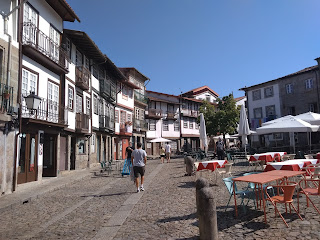So...on the Portuguese highway headed south from Guimarães, I thought it would be a good idea to call the campground I had researched to make sure they had space. Ya know, just in case. After all, the planning for this trip had been up to me. Stubbornly, I didn't need any help. As you can imagine, I wouldn't be writing about it if they had had spots available. Desperately I tried calling a few other places in my broken Galician-Portuguese mix. While looking up campsite reviews online. And trying to stay calm and not get my vacation-planning privileges revoked. But honestly, it was just as well that our plan A didn't work out. That campground had been in the middle of nowhere, whereas our final campground was amidst a natural park with lagoons. It had a pool, a snack bar, and plenty of open area to pitch a tent. It was also just a short walk from the coastal village Praia de Mira.
Praia de Mira ended up being where we spent more time than Aveiro, as originally planned. It was a bustling beach town in the summer months, and likely quite dead in the winter. You know the drill. The area was curious because to the west was a long beach, which has been a Blue Flag Beach since the honor has existed. Then there was the town, a few streets parallel with the sea. Then there was an inner lagoon. That area was full of campgrounds. It had a nice, new boardwalk amongst the wetlands. In the evening it was lit beautifully and you could stop to enjoy the calm on large swings.
 |
| Beyond the trees: the lagoon |
 |
| Note the tiny coffee cup |
Side note on the coffee: the regular coffee cups are a little bigger than a shotglass. Looking up some Portuguese vocabulary we had found tons of different words for coffee styles. While seeking a coffee with milk, which would be served in a small mug here in Spain, they brought said tiny coffee cup, full to the brim. Huh? I wanted it with milk. ¨I'm pretty sure that is a coffee with milk.¨ I myself am not a coffee drinker, but to prove a point I ordered a ¨plain coffee¨ in the next place. Sure enough, the ¨regular¨ without milk was barely half of the tiny coffee cup. One sip and done! But it really packs a punch.



